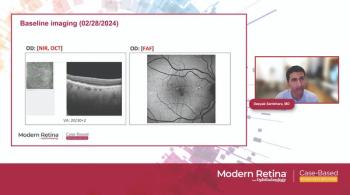
Structure-function link between ellipsoid zone integrity features and visual acuity in eyes with GA
A recent analysis reveals a strong link between photoreceptor health and visual function in geographic atrophy, emphasizing the importance of EZ integrity.
A presentation at the Association for Research in Vision and Ophthalmology 2025 annual meeting in Salt Lake City found that a post hoc analysis of the data from the GATHER1 and GATHER2 studies showed a clear structure-function link in
The investigators pointed out that the features of the ellipsoid zone (EZ) integrity have been associated with visual function in multiple retinal conditions.1 The EZ is a biomarker of photoreceptor integrity observed on spectral-domain optical coherence tomography (SD-OCT) and loss of the EZ is a key marker of disease progression in GA.2
Matar and colleagues conducted a post hoc analysis of the GATHER1 and GATHER2 pooled data to evaluate the relationship between the best-corrected visual acuity (BCVA) and the features of the EZ at baseline in eyes with GA.
The phase 2/3 GATHER1 (NCT02686658) and phase 3 GATHER2 (NCT04435366) clinical trials were multicenter, randomized, double-masked, sham-controlled trials that examined the efficacy and safety of avacincaptad pegol 2 mg (Izervay, Astellas Pharma Inc.) in patients with GA that did not involve the central fovea.3,4
The eyes were divided into quartiles (Q) according to the baseline BCVA and were designated as Q1 (low) to Q4 (high), with Q1 (170 eyes) indicating a BCVA of 67 letters or less at baseline (Snellen, 20/50 or worse) and Q4 (153 eyes) indicating a BCVA over 77 letters at baseline (Snellen, 20/32 or better)
Post hoc analysis outcomes
The investigators reported that the mean partial EZ attenuation/degradation at baseline was greater in eyes in Q1 than those in Q4 within the central 1- and 2-mm subfields. The mean partial EZ percentages of attenuation in the central 1-mm subfield in Q1 and Q4, respectively, were 86.6% and 57.7%.
In the central 2-mm subfield, the respective partial attenuation percentages were 92.0% and 72.4%.(P < 0.0001).
Likewise, the mean total EZ attenuation/loss at baseline was greater in eyes in Q1 than in Q4. In the central 1-mm subfield, the respective percentages were 63.6% and 34.3%. In the central 2-mm subfield the respective percentages were 74.7% and 51.6% (P < 0.0001).
The authors also found that the mean EZ-retinal pigment epithelial central subfield thickness at baseline was greater in eyes in Q4 than in Q1, ie, 16.3 and 6.7 microns, respectively (P < 0.0001).
“This post hoc analysis showed the clear structure-function link in GA between the photoreceptor health, measured by the EZ integrity, and visual function, measured by the BCVA. In particular, eyes with better vision exhibited greater preservation of the EZ integrity at baseline more effectively than those with poorer vision, highlighting the significance of photoreceptor preservation in the management of GA and dry age-related macular degeneration (AMD). These results suggested that EZ loss may be a critical component to vision loss in dry AMD. Thus, using these biomarkers may help guide clinical decision-making in the management of GA and future clinical trial design,” the investigators concluded.
References
Yordi S, Cakir Y, Kaira G, et al.Ellipsoid zone integrity and visual function in dry age-related macular degeneration.J Pers Med. 2024;14(5):543.
Abraham J, et al. Poster presented at ARVO 2024. Seattle, WA, USA. May 5-9, 2024. Poster 5711-B0117.
Jaffe GJ, Westby K, Csaky KG, et al. C5 Inhibitor avacincaptad pegol for geographic atrophy due to age-related macular degeneration: a randomized pivotal phase 2/3 trial. Ophthalmology. 2021;128(4):576-586.
Khanani AM, Patel SS, Staurenghi G, et al. Efficacy and safety of avacincaptad pegol in patients with geographic atrophy (GATHER2): 12-month results from a randomized, double-masked, phase 3 trial. Lancet. 2023;402(10411):1449-1458
Newsletter
Keep your retina practice on the forefront—subscribe for expert analysis and emerging trends in retinal disease management.








































